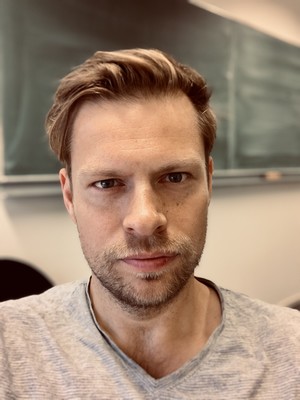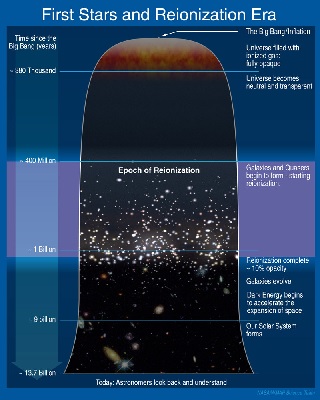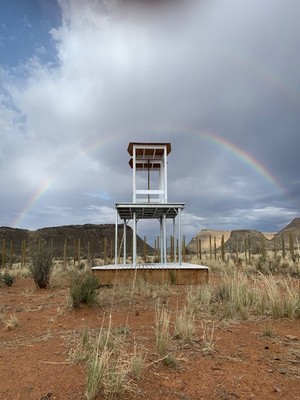Answering big questions with a simple telescope
There is a lot that we do not know about the Universe. Why is it here in the first place? And what is the nature of elusive components such as dark matter or dark energy? Some of the answers may hide in the glow that was emitted by neutral hydrogen atoms during the cosmic dawn. Daan Meerburg, a physicist at the University of Groningen, is working on the data analysis pipeline for a telescope that will be able to observe this extremely faint glow. A general description was published in Nature Astronomy on 21 July.
We know a lot about stars and galaxies by studying the electromagnetic radiation that they emit—from radio waves to visible light. Each chemical element has its own specific wavelength profile in which it absorbs or emits radiation and this allows us to probe the composition of stars and galaxies. But these structures will not tell us the whole story of the Universe. That is why astronomers also study radiation that is distributed across the entire sky, such as the cosmic microwave background. It is from these cosmic signals that we can learn about the fundamental structures behind reality.

Microwave background
‘We want to look at the cosmic signal of neutral hydrogen,’ says Daan Meerburg, assistant professor at the University of Groningen. He is part of an international collaboration called REACH (Radio Experiment for the Analysis of Cosmic Hydrogen), led by the University of Cambridge (UK), that is building a telescope in South Africa to accomplish this. Hydrogen atoms, just one proton and one electron, have been present since roughly 370,000 years after the Big Bang, at the time when the opaque Universe became translucent. The first light that was emitted then is now visible as the cosmic microwave background (CMB). Small variations in the CMB hint at a non-uniform distribution of matter and this gives us information on how large structures in the Universe came into being.
‘However, the CMB provides us with a 2D map of the cosmos,’ explains Meerburg. ‘And it only shows luminous matter.’ Neutral hydrogen could transform this into a 3D map of the large-scale structure of the Universe, since it is omnipresent. This hydrogen emits radiation with a wavelength of 21 centimetres. Furthermore, it is the first light that appeared after a period called the cosmic Dark Ages, which ended when the Universe was approximately one billion years old. From this cosmic dawn onwards, light from stars and galaxies began to dominate. ‘We know very well how neutral hydrogen behaves and what its emissions from the early Universe should look like now.’ These emissions depend on temperature. Meerburg: ‘The hydrogen can be heated up by interaction with the CMB or cooled down by interaction with gas clouds.’
Antenna
A problem in studying the light that the primordial hydrogen emits is that it is very weak compared to the foreground of light that is emitted by the Milky Way. Only by careful subtraction of this younger and brighter light is the old hydrogen radiation visible. ‘But it is possible, in theory, to catch this light with a relatively simple antenna. Also, we are interested in variations in this hydrogen radiation across length scales and this makes it a bit easier to distinguish it from the bright foreground.’

Error
Indeed, in 2018, another group claimed to have detected the neutral hydrogen radiation from the cosmic dawn. Meerburg: ‘The shape of the light curve was not as expected and could only be explained by invoking new physics. However, by analysing the data that they made public, we discovered that by changing a few parameters describing the properties of the foreground we ended up with an entirely different curve.’ This may point to an error in data processing.
‘There are lots of corrections to be made for factors that can affect the measurements,’ explains Meerburg. ‘For example, in the way that the foreground is subtracted, but also in every part of the antenna system and its interaction with the surroundings.’ Most groups take a step-by-step approach to these corrections. The REACH group has a unique approach to this problem: ‘Because everything is linked, we are combining all elements and process them simultaneously.’ Meerburg, who is developing a data analysis pipeline for REACH, is convinced that this approach is superior. ‘We have shown that our approach works in simulations.’
Results
The paper in Nature Astronomy describes the construction of the telescope and the data analysis that the REACH group will use. ‘It is an overview of the entire project, which is being described in at least two dozen, more detailed papers.’ All this information on the project is important for other scientists to assess the results when they arrive.

Moon
Once the cosmic neutral hydrogen signal from the cosmic dawn is found, there will be a lot to learn. ‘You could compare it to recording the first gravity waves—the field exploded after the initial observation.’ The hydrogen signal could tell us more about the nature of dark energy and dark matter. These two factors make up most of the energy content of the Universe but physicists do not know exactly what they are. ‘And it may tell us how galaxies began to form and perhaps even why the Universe came into existence.’
Meanwhile, Meerburg and his PhD student Anchal Saxena are working hard on an analysis pipeline. Theirs is currently an alternative pipeline, in addition to the core pipeline. ‘You need more than one approach to make certain that your results are robust.’ To both, the REACH project is not their only research interest. Meerburg became involved with REACH when he worked at the University of Cambridge. He is now an assistant professor in the Cosmic Frontier group, which is part of the Van Swinderen Institute for Particle Physics and Gravity Waves. ‘My main research is on cosmic microwave background but I’m also involved in a project that aims to put a radio observatory on the moon. A Chinese mission already placed an antenna on the dark side of the moon. And that is also the best location to study the hydrogen system, since there is no interference from human radio sources or the Earth’s atmosphere.’ But first, the telescope in South Africa must produce results and open a new window into the history of our Universe.
Reference: E. de Lera Acedo et al: Tee REACH radiometer for detecting the 21-cm hydrogen signal from redshift z ≈ 7.5–28. Nature Astronomy, 21 July 2022
| Last modified: | 05 October 2022 7.26 p.m. |
More news
-
29 April 2024
Tactile sensors
Every two weeks, UG Makers puts the spotlight on a researcher who has created something tangible, ranging from homemade measuring equipment for academic research to small or larger products that can change our daily lives. That is how UG...
-
16 April 2024
UG signs Barcelona Declaration on Open Research Information
In a significant stride toward advancing responsible research assessment and open science, the University of Groningen has officially signed the Barcelona Declaration on Open Research Information.
-
02 April 2024
Flying on wood dust
Every two weeks, UG Makers puts the spotlight on a researcher who has created something tangible, ranging from homemade measuring equipment for academic research to small or larger products that can change our daily lives. That is how UG...

